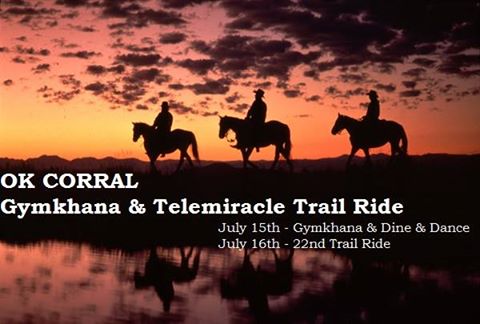
July 2017
FUNDRAISER GYMKHANA - SUPPER & DANCE TO FOLLOW This is a family event. Young or old bring your pony, dancin boots & a smile! (this includes a silent auction - all donation prizes are appreciated)
Find out more
OK Corral is located just past Martensville. Take highway 12 and go over the railroad tracks, Turn right at Power Line Road (Township rd 392), turn right at Range rd 3053. OK Corral is just on your left hand side. Enter on the second driveway.
FUNDRAISER GYMKHANA - SUPPER & DANCE TO FOLLOW This is a family event. Young or old bring your pony, dancin boots & a smile! (this includes a silent auction - all donation prizes are appreciated)
Find out morePressure is sometimes called “asking” (the horse to do something, or to accept something). You may ask a horse to back up, and you may ask a horse to accept you scratching their ears. You may also ask a horse to accept/learn to be comfortable with something that is new to them, such as a plastic bag tied onto the end of a stick.
Pressure engages the horse’s mind, emotions and body. In most cases the horse will react physically (which may be the goal). An example of an emotional reaction to pressure is fear, such as when a horse moves away from something new that they are being introduced to.
Release is a term used to describe the point at which you cease to put pressure on the horse. Timing of the release is important, because a premature release does not motivate the horse to learn (and neither does “too little” pressure). Releasing pressure too late results in unnecessary (and probably damaging) emotional stress on the horse.
More about Pressure and Release: Using the Pressure and Release Theory to Teach Your Horse
Related Article: Using Baby Steps to Teach Your Horse New Skills.
Level of acceptance by the horse, of an object or person. If the horse fears an object or will not tolerate it, their acceptance level of the object is low. If they completely tolerate and accept an object (such as a tarp on their back), their acceptance level is high, or “good.”
The level of fear that the horse is experiencing, in response to a stimuli (sight, sound, touch, smell).
The fear index of horse that is relaxed when exposed to fire would be deemed “low” (“a low fear index”). The fear index of a horse that bolts (runs away) from fire would be deemed “high” (“a high fear index”).
Related Article: How to “Read Your Horse” by Observing Her Actions and Appearance.
Mini-goals used to build a horse’s confidence and encourage acceptance of stimuli (sights, smells, touch, sounds). Once reached, the mini-goals then become stepping stones, relied on in future teaching objectives.
Related Article: How to “Read Your Horse” by Observing Her Actions and Appearance
Accomplishments (solid skills) that can be relied on when teaching a horse a new skill. For example, the ability to carry a tarp without fear can be used when a rider wants to carry a flag, because the horse is already comfortable with the flag’s movement and the sound that it makes.
Related Article: Using Baby Steps to Teach Your Horse New Skills.
“Old News” is any object, situation or task that the horse has had previous experience with, to the point where it does not cause an emotional of physical reaction. For example,
Related Article: Using Baby Steps to Teach Your Horse New Skills.
Related Article: Using Baby Steps to Teach Your Horse New Skills.
In reaction to our horse’s behaviour, we have three options: to ignore the behaviour, to correct the behaviour, or to praise the behaviour.
Ignoring behaviour reduces the likelihood that the horse will make unnecessary or undesired emotional attachments to that behaviour.
Correcting behaviour is necessary when the horse exibits behaviour that is undesirable.
Praise is necessary to reward desired behaviour, so that the horse will repeat it.
More About Ignore, Correct or Praise: The Ignore, Correct or Praise Theory
Related Article: Using Baby Steps to Teach Your Horse New Skills.
